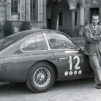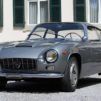
- Introduction to Zagato
- The Panoramica Era: Post-War Reinvention
- The 1920s and 1930s: Establishing a Presence in Racing
- Iconic Models of the Panoramica Era (1947-1950)
- 1947 Fiat 1100 Panoramica
- 1947 Isotta Fraschini 8C Monterosa
- 1947 Maserati A6 1500 GT Panoramica
- 1947 Fiat 1400 Panoramica
- 1948 Fiat 500B Topolino
- 1948 Fiat 750 MM “Scansina”
- 1948 MG 1500 Panoramica
- 1949 Alfa Romeo 8C 2300 M
- 1949 Ferrari 166 MM Panoramica
- 1949 Lancia Ardea Panoramica
- 1950 Fiat 1100 Giardinetta
- Portfolio of Panoramica Vehicles
- Conclusion
Introduction to Zagato
Zagato An Investment Portfolio of Automotive Masterpieces. Zagato, the legendary Italian coachbuilding company, was founded by Ugo Zagato in 1919. After transitioning from the aeronautical industry, where he worked on biplanes during World War I, Ugo brought radical innovations to the automotive sector. By combining his expertise in lightweight materials with a meticulous focus on aerodynamics, he set new standards for the design of both racing and luxury cars. This in-depth analysis explores key moments and major works of Zagato, with particular emphasis on the Panoramica era that followed World War II.
The Beginnings: From Aeronautics to Automobiles
Aviation Background
Ugo Zagato began his career as an aircraft designer for Officine Pomilio during World War I. His work involved designing fast, lightweight biplanes capable of quick and surprising maneuvers. One of the most notable examples of his work was the aircraft used by Gabriele D’Annunzio for his famous propaganda flight over Vienna in 1918. This experience cemented Zagato’s belief that lightness and aerodynamics were essential for performance a philosophy he later applied to automobile design.
Aerospace Experience
Before founding Carrozzeria Zagato, Ugo Zagato worked for Officine Pomilio, where he designed light, fast biplanes suited for quick maneuvers and the demanding conditions of aerial combat. Zagato’s experience in aircraft design, including the aircraft used by Gabriele D’Annunzio for his 1918 flight over Vienna, proved pivotal. Upon transitioning from the aerospace industry to automotive coachbuilding in 1919, Zagato introduced the use of lightweight materials such as aluminum and innovative construction techniques.
The Panoramica Era: Post-War Reinvention
Historical Context
Zagato An Investment Portfolio of Automotive Masterpieces .Following World War II, Zagato introduced the “Panoramica” concept, marking a new chapter in automotive coachbuilding history. Collaborating with engineer Vieri Rapi from Isotta Fraschini, Zagato employed Plexiglass for the upper sections of windshields and side and rear windows, offering outstanding panoramic visibility. This innovative design, inspired by aircraft cockpits, enhanced visibility and introduced a new level of comfort and luminosity to vehicle interiors.
Technological Innovations
The Panoramica concept was directly inspired by aircraft cockpits, offering drivers and passengers enhanced visibility similar to that of pilots. Plexiglass, a lightweight and flexible material, allowed for curves that were impossible with traditional glass. This innovation not only improved visibility but also reduced vehicle weight, enhancing performance and fuel efficiency.
The 1920s and 1930s: Establishing a Presence in Racing
Revolution in Materials
During the 1920s and 1930s, Zagato distinguished itself through its revolutionary use of lightweight materials. Wooden chassis were replaced with steel, and heavy bodywork was replaced with aluminum structures. This approach significantly reduced vehicle weight, thereby enhancing their performance on race tracks. Zagato’s cars rapidly accumulated victories across various racing categories, proving the effectiveness of his designs.
Aerodynamic Innovations
Beyond materials, Zagato also focused on aerodynamics. His 1930s race cars were characterized by streamlined bodies, devoid of fenders or external headlights, resembling torpedoes. These vehicles were designed specifically to achieve high speeds and set new records. Collaborations with prestigious brands such as Alfa Romeo, Fiat, and Lancia allowed Zagato to perfect his aerodynamic concepts, laying the groundwork for future successes.
Iconic Models of the Panoramica Era (1947-1950)
1947 Fiat 1100 Panoramica
One of the earliest Panoramica models, based on the Fiat 1100 chassis, featured a raised roofline and Plexiglass glazing. Fixed windows offered improved visibility, though they were not ideal for hot summer days. Race drivers appreciated this increased visibility, turning the vehicle into a “fast greenhouse.”
- Chassis: Fiat 1100
- Body: Aluminum with Plexiglass windows
- Features: Raised roof, enhanced visibility, fixed windows
1947 Isotta Fraschini 8C Monterosa
After the war, Isotta Fraschini attempted a return to automotive production with the 8C Monterosa, a rear-engine model designed by several coachbuilders, including Zagato. Despite several prototypes built between 1947 and 1949, the high cost of the model prevented mass production. Zagato constructed three prototypes influenced by the Panoramica concept, incorporating aerodynamic design elements.
- Chassis: Isotta Fraschini 8C
- Body: Aluminum, Panoramica influence
- Features: Rear engine, multiple prototypes
1947 Maserati A6 1500 GT Panoramica
In 1948, Maserati sent a rolling chassis to Zagato, which was transformed into a Panoramica-style coupe in aluminum. This first collaboration between Maserati and Zagato resulted in a unique vehicle, recognizable primarily by the classic Maserati front grille.
- Chassis: Maserati A6 1500
- Body: Aluminum, Panoramica coupe style
- Features: First collaboration with Maserati
1947 Fiat 1400 Panoramica
Similar to the Fiat 1100, this model was based on a more powerful 1400 cc chassis. The side windows were divided into two sections by a metal frame, allowing them to open, suggesting private use rather than racing. Chrome decorations added a touch of luxury.
- Chassis: Fiat 1400
- Body: Aluminum with divided windows
- Features: Chrome decorations, private use
1948 Fiat 500B Topolino
From 1947, a dedicated production line for the Topolino B was established. This model saw notable public success and was produced until 1950, illustrating the adaptability of the Panoramica concept to various sizes and styles of vehicles.
- Chassis: Fiat 500B
- Body: Aluminum, production until 1950
- Features: Dedicated production line, public success
1948 Fiat 750 MM “Scansina”
Built in only eight examples, this model based on the Fiat Topolino had a more powerful 750 cc engine. Elio Zagato, Ugo’s son, achieved numerous victories with this model. It was also on this model that the “Z” logo of Zagato was introduced, designed by the young designer Gianni, Elio’s brother.
- Chassis: Fiat Topolino
- Body: Aluminum, 750 cc engine
- Features: Competition model, introduction of the “Z” logo
1948 MG 1500 Panoramica
Zagato also applied the Panoramica concept to British chassis, such as this MG 1500 Y-Type, which was showcased at the Earl’s Court Motor Show in 1948 and participated in the 1949 Concours d’Élégance in Lugano.
- Chassis: MG 1500 Y-Type
- Body: Aluminum, Panoramica style
- Features: Showcased at Earl’s Court Motor Show
1949 Alfa Romeo 8C 2300 M
Built on an Alfa Romeo 8C 2300 chassis, this Panoramica model mixed flamboyant style elements. It was made in a single example, based on a damaged 1933 race chassis. The vehicle was rediscovered in Africa in the 1960s and restored to its original racing configuration.
- Chassis: Alfa Romeo 8C 2300
- Body: Aluminum, Panoramica style
- Features: Unique example, flamboyant style mix



1949 Ferrari 166 MM Panoramica
Commissioned by Antonio Stagnali, this model is considered a milestone in the evolution of the coupe body concept. It was the first of a long series of Ferraris coachbuilt by Zagato. In 2007, on Ferrari’s 60th anniversary, Zagato recreated this lost model using photometric processes and support from Ferrari Classiche.
- Chassis: Ferrari 166 MM
- Body: Aluminum, Panoramica style
- Features: First Ferrari coachbuilt by Zagato, recreated in 2007



1949 Lancia Ardea Panoramica
A unique Zagato proposal on the Lancia Ardea chassis, featuring a highly aerodynamic and futuristic body for its time. This model is likely a one-off.
- Chassis: Lancia Ardea
- Body: Aluminum, Panoramica style
- Features: Unique model, futuristic aerodynamic design
1950 Fiat 1100 Giardinetta
The Panoramica concept was also used to create “Giardinetta,” the Italian term for station wagons. At least two models were built, based on the Fiat 500C Topolino and the Fiat 1100.
- Chassis: Fiat 1100
- Body: Aluminum, Giardinetta style
- Features: Panoramica concept adapted for station wagons
Portfolio of Panoramica Vehicles
Zagato An Investment Portfolio of Automotive Masterpieces :
- 1947 Fiat 1100 Panoramica
- 1947 Isotta Fraschini 8C Monterosa
- 1947 Maserati A6 1500 GT Panoramica
- 1947 Fiat 1400 Panoramica
- 1948 Fiat 500B Topolino
- 1948 Fiat 750 MM “Scansina”
- 1948 MG 1500 Panoramica
- 1949 Alfa Romeo 8C 2300 M
- 1949 Ferrari 166 MM Panoramica
- 1949 Lancia Ardea Panoramica
- 1950 Fiat 1100 Giardinetta
Conclusion
Zagato An Investment Portfolio of Automotive Masterpieces.The story of Zagato is a celebration of innovation, elegance, and performance. By merging aeronautical techniques with automotive design, Ugo Zagato transformed the industry and left a lasting legacy. The Panoramica models represent a pivotal era, showcasing Zagato’s ingenuity and forward-thinking. These vehicles, combining lightness and panoramic visibility, remain icons of post-war automotive design.







